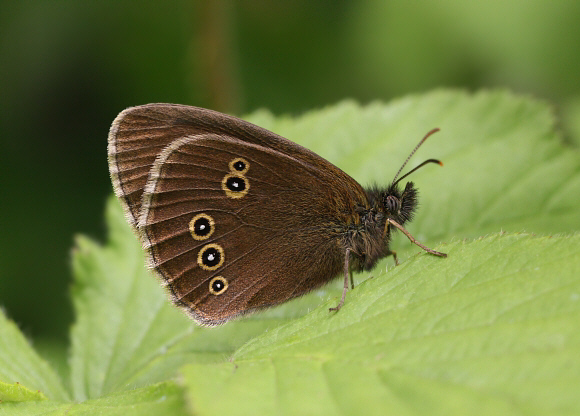 Ringlet Aphantopus hyperantus, male, Bedwyn, Wiltshire – Adrian Hoskins
Ringlet Aphantopus hyperantus, male, Bedwyn, Wiltshire – Adrian Hoskins
Introduction
The Ringlet is a common and widely distributed species found throughout Europe with the exception of northern Scandinavia, peninsular Italy, Portugal, southern / central Spain, and the Mediterranean islands. Beyond Europe it is found across much of temperate Asia including Siberia, Mongolia, China and Korea.
The sexes are almost identical but the male has a barely visible dark diagonal patch of androconial scales on the forewings, and the anal claspers at the tip of his abdomen are visible when the wings are outspread.
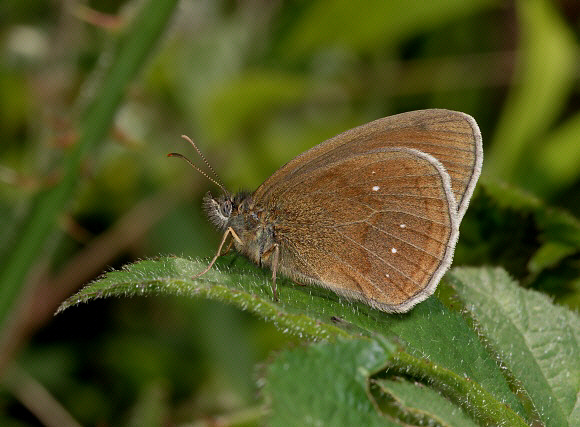 A ‘blind’ Ringlet Aphantopus hyperantus, ab caeca, Bentley Wood, Wiltshire – Adrian Hoskins
A ‘blind’ Ringlet Aphantopus hyperantus, ab caeca, Bentley Wood, Wiltshire – Adrian Hoskins
There is considerable variation in the size and shape of the ocelli on the underside wings. At certain sites a small percentage of the population have the yellow rings absent, and the inner ocelli reduced to tiny dots. This form is known as ab. caeca. Another aberration occurs in which the ocelli are all enlarged and extended into a tear-drop or pear shape. This is known as ab. lanceolata. Both forms are caused by the sporadic re-emergence of recessive genes. A number of other named varieties occur which are intermediate between these extremes. The number of ocelli is constant, regardless of their size – there are 2 on each forewing and 5 on each hindwing, hence the butterfly was known to early entomologists as the ‘Brown Seven Eyes’.
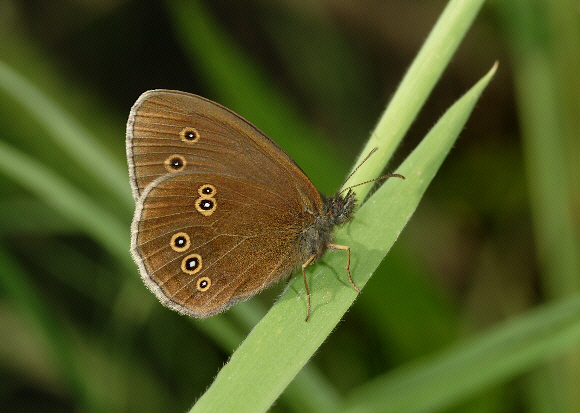 The ‘Brown Seven Eyes’ or Ringlet Aphantopus hyperantus, � Adrian HoskinsIn Britain the Ringlet can be confused in flight with the Meadow Brown, but the latter always has a trace of orange suffusion on the outer half of the forewings, and a concave outer margin. It also lacks the distinctive white fringes of the Ringlet, and has completely different underside markings.
The ‘Brown Seven Eyes’ or Ringlet Aphantopus hyperantus, � Adrian HoskinsIn Britain the Ringlet can be confused in flight with the Meadow Brown, but the latter always has a trace of orange suffusion on the outer half of the forewings, and a concave outer margin. It also lacks the distinctive white fringes of the Ringlet, and has completely different underside markings.
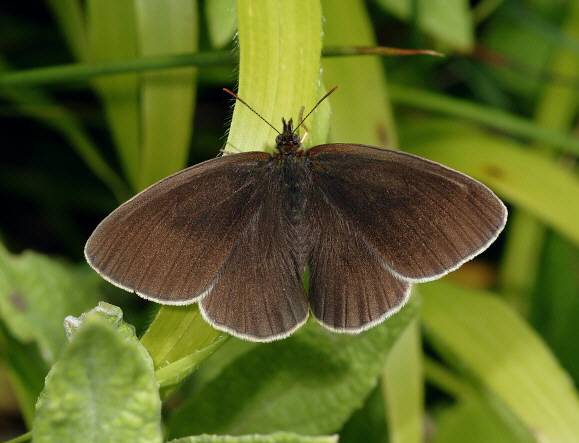 Ringlet Aphantopus hyperantus, ab caeca, Stockbridge Down, Hampshire – Adrian Hoskins
Ringlet Aphantopus hyperantus, ab caeca, Stockbridge Down, Hampshire – Adrian Hoskins
Habitats
In Britain Aphantopus hyperantus is found commonly throughout most of England, but is scarcer in the north west. In Scotland it is very common in the south west but scarce elsewhere, and absent from the extreme north. Wales has strong populations in the valleys and low lying areas.
The Ringlet breeds primarily in damp open woodlands, inhabiting rides and glades where grasses grow tall and lush. At these sites populations often contain several hundred individuals. It is found in much lesser numbers on scrubby grassland, where it occupies damp, sheltered hollows which have escaped grazing. Other habitats used by this species include hedgerows, ditches, railway cuttings, field margins and narrow country lanes.
Populations vary considerably in number from year to year at any given site, the controlling factor being the weather. Most butterfly species seem to do best when a long cold winter is followed by a warm and sunny summer, with moderate but regular rainfall. Ringlets however fare much better if the spring and early summer are dominated by overcast and damp weather. This is one of the few European butterflies which will continue to fly during light rainfall. In hot summers Ringlets usually tend to be scarce, and it can take 2 or 3 years of wetter summers for populations to recover.
 Ringlet Aphantopus hyperantus, Castle Copse, Wiltshire – Adrian Hoskins
Ringlet Aphantopus hyperantus, Castle Copse, Wiltshire – Adrian Hoskins
Lifecycle
The adults emerge in late June and early July, but the flight season is quite short, and the butterfly has generally disappeared by the end of July.
Ringlets don’t glue their eggs to leaves. Instead they drop them loosely as they sit on a blade of grass. The eggs drop to the ground, although most adhere to grass blades as they fall. Oviposition sites are usually close to bushes. The eggs are shiny, almost spherical, tapering slightly towards the top. They are pale buff in colour, becoming darker after a few days.
The caterpillars hatch after about 2 weeks and feed nocturnally on the tender blades of cock’s foot grass Dactylis glomerata or wood false brome Brachypodium sylvaticum. Other species used less often include tufted hair grass Deschampsia caespitosa, annual meadow grass Poa pratensis, and Agropyron repens. Additional species are used in continental Europe. In September, when in the 2nd or 3rd instar, they enter hibernation but awaken to feed on warmer evenings during the winter.
In March of the following year they resume feeding in earnest. They hide during the day at the base of grass tufts, but at dusk they crawl up to feed and can be observed by torch-light resting on grass stems. If disturbed they roll into a ball and drop to the ground. The fully grown larva is a dull olive-brown colour with a dark stripe along its back, and paler lines along the sides.
The pupa is formed within a very flimsy cocoon ( little more than a few strands of silk ), at the base of a tuft of grass. It is pale brown, marked on the wing cases with darker streaks and tiny dots.
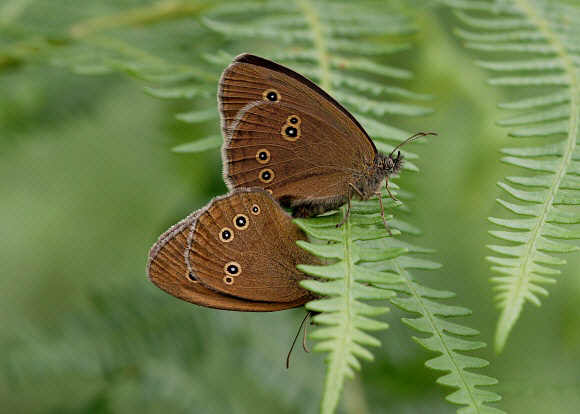 Ringlet Aphantopus hyperantus, Bentley Wood, Wiltshire – Adrian Hoskins
Ringlet Aphantopus hyperantus, Bentley Wood, Wiltshire – Adrian Hoskins
Adult behaviour
Ringlets are noted for their characteristic flip-flop flight over short distances, and rarely cover more than a few metres at a time. They are most active in warm but overcast conditions, and will fly even during light rain. In overcast conditions they are commonly seen basking on bracken or other low vegetation. When it is sunny they tend to spend long periods at rest with wings closed, but in years such as 2013 when there was a long hot dry spells in early July I watched them swarming on dozens around hazel bushes or the lower branches of oaks, pausing only momentarily to imbibe honey-dew from the leaves. Other commonly used food sources include bramble blossom and thistles.
Copulation takes place in the late morning or early afternoon, and rarely lasts longer than half an hour. When copulated the butterflies usually sit on the stems or leaves of low herbage.
In June 2008 at Alice Holt forest in Hampshire I witnessed an amusing incident where a confused male spent about 2 minutes chasing a freshly emerged Red Admiral around in tight circles. The Red Admiral has a powerful flight so could easily have escaped, but it chose to ‘play along’, allowing the Ringlet to maintain close contact throughout the sortie. On another occasion I watched a Ringlet as it was intercepted by a territorial male Large Skipper – to my surprise the traditionally placid Ringlet suddenly took on a great spurt of speed and chased the skipper away.
Overnight and in rainy weather Ringlets hide deep in vegetation, choosing spots adjacent to bushes.
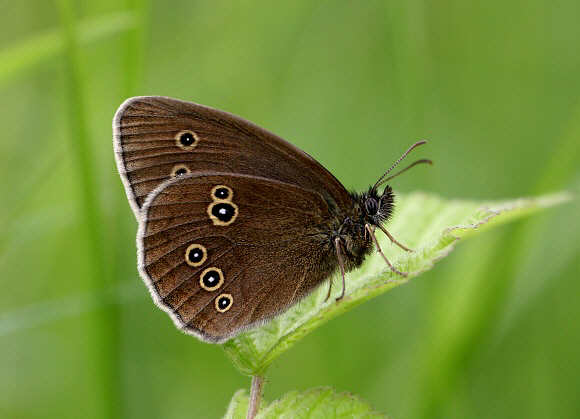
Ringlet Aphantopus hyperantus Monks Wood, Northants – Adrian Hoskins
